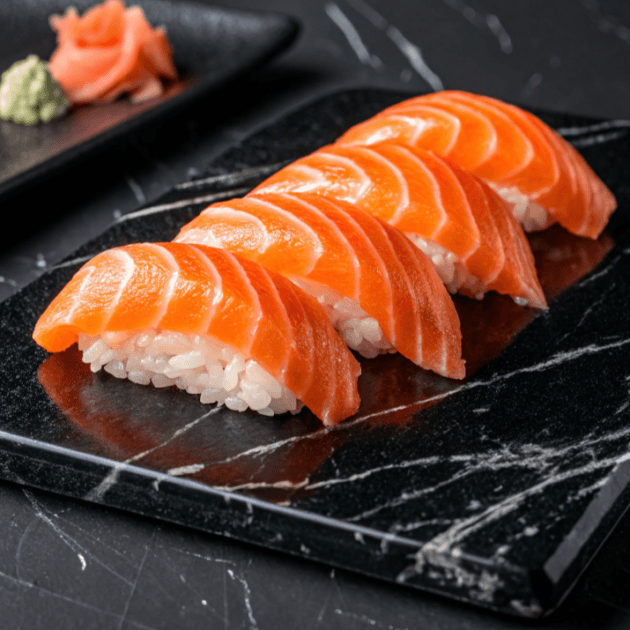Salmon sushi is a beloved dish in Japanese cuisine, praised for its buttery texture and rich flavor. Whether you’re a sushi enthusiast or a beginner, this guide explores its history, types, preparation tips, nutritional benefits, and common FAQs.
A Brief History of Sushi and Salmon’s Role
Early Sushi Origins
Sushi began as a fermentation method in ancient Southeast Asia to preserve fish. Over centuries, it transformed into a culinary art, emphasizing fresh ingredients.
How Salmon Became Part of Sushi Culture
Traditionally, salmon was avoided in Japan due to parasite risks. However, in the 1980s, Norwegian salmon farmed in parasite-free waters revolutionized sushi culture, making salmon sushi globally popular.
Types of Salmon Sushi
1. Nigiri Sushi (Classic Style)
Nigiri sushi is one of the most traditional forms of sushi, showcasing the freshness and quality of the salmon. It consists of:
- A hand-pressed mound of vinegared rice.
- A thin slice of sushi-grade salmon draped on top.
- Often finished with a dab of wasabi between the rice and salmon for an extra kick of flavor.
Variations of Nigiri Sushi:
- Aburi Salmon Nigiri: The salmon is lightly seared with a kitchen torch, adding a smoky aroma and caramelized flavor.
- Gunkan-Maki (Battleship Style): A small oval-shaped rice ball wrapped in nori and topped with salmon roe (ikura) for an elevated experience.
- Zuke Salmon Nigiri: Features marinated salmon that absorbs extra umami flavors before being served.
Nigiri sushi highlights the simplicity and purity of ingredients, making it a go-to choice for sushi purists.
2. Sashimi (Pure Salmon)
Sashimi is the simplest and purest form of enjoying salmon sushi, focusing entirely on the taste and texture of the fish. It consists of:
- Thinly sliced pieces of raw salmon.
- Served without rice, allowing the fish’s natural flavor to stand out.
Ways to Serve Sashimi:
- Accompaniments: Often served with daikon radish, shiso leaves, lemon wedges, and a side of soy sauce or ponzu sauce.
- Dipping Options: Pair with wasabi for heat or yuzu ponzu for a citrus twist.
- Variations:
- Salmon Carpaccio: Thinly sliced salmon dressed with olive oil, capers, and citrus.
- Tataki Style: Salmon is briefly seared on the outside while remaining raw inside.
Sashimi is perfect for those who appreciate the flavor of raw salmon in its purest form.
3. Sushi Rolls (Makizushi)
Makizushi, or rolled sushi, is a versatile style of salmon sushi that combines flavors and textures. It is wrapped in nori (seaweed) and often features fillings such as avocado, cucumber, and cream cheese.
Popular Types of Salmon Rolls:
- Salmon Roll:
- Simple and elegant, combining fresh salmon and seasoned rice wrapped in nori.
- Often served with soy sauce or wasabi.
- Philadelphia Roll:
- A Western-inspired fusion roll featuring salmon, cream cheese, and cucumber.
- Provides a creamy texture that complements the richness of the salmon.
- Spicy Salmon Roll:
- Combines diced salmon with spicy mayo or sriracha sauce for a fiery kick.
- Often garnished with sesame seeds, green onions, or crunchy tempura flakes.
- Dragon Roll with Salmon:
- Features grilled eel or avocado layered on top of a salmon-filled roll.
- Drizzled with teriyaki glaze for a sweet and savory finish.
- Rainbow Roll:
- A colorful roll featuring slices of salmon, tuna, and other seafood layered over a California roll base.
- Perfect for those who want a variety of flavors in one bite.
- Temaki (Hand Rolls):
- Cone-shaped rolls wrapped in nori, filled with salmon, avocado, and spicy sauces.
- Designed for a casual, handheld experience.
Vegetable Pairings in Rolls:
Salmon pairs beautifully with vegetables such as:
- Avocado: Adds creaminess.
- Cucumber: Provides a refreshing crunch.
- Pickled radish and carrots: Add tanginess and color.
4. Specialty Salmon Sushi Variations
For those seeking modern twists on salmon sushi, specialty options incorporate innovative techniques and global flavors:
- Spicy Salmon Tartare:
- Features finely chopped salmon mixed with spices, chili mayo, and scallions.
- Often served as an appetizer or sushi topping.
- Salmon Tempura Roll:
- Includes deep-fried salmon wrapped in nori and rice, offering a crispy texture.
- Topped with eel sauce or spicy mayo.
- Salmon and Mango Roll:
- Combines sweet mango slices with raw salmon, creating a tropical flavor profile.
- Salmon Poke Bowl:
- Inspired by Hawaiian cuisine, featuring diced salmon served over rice with edamame, seaweed salad, and avocado.
- Aburi-Style Salmon:
- Lightly torched salmon, giving it a smoky flavor while retaining a raw center.
Key Ingredients and Tools for Salmon Sushi
Ingredients
- Sushi-Grade Salmon
- The most important ingredient in salmon sushi. It must be flash-frozen to eliminate parasites, ensuring it’s safe for raw consumption.
- Look for salmon with a vibrant color, firm texture, and mild aroma. Always purchase from a trusted fishmonger or store specializing in sushi-grade seafood.
- Rice (Shari)
- Use short-grain Japanese rice, known for its sticky texture, which helps hold the sushi together.
- Season the rice with a blend of rice vinegar, sugar, and salt to achieve the signature tangy flavor.
- Rinse the rice thoroughly before cooking to remove excess starch and ensure the grains are light and fluffy.
- Nori (Seaweed Sheets)
- Choose high-quality nori that is dark green, crisp, and shiny.
- Used to wrap sushi rolls (makizushi) or as a garnish for hand rolls (temaki).
- Toppings and Fillings
- Avocado: Adds a creamy texture that pairs well with salmon.
- Cucumber: Provides a crisp crunch and refreshing flavor.
- Sesame Seeds (White or Black): Offer a nutty flavor and enhance presentation.
- Tobiko (Fish Roe): Adds a burst of flavor and a vibrant color.
- Cream Cheese: Often used in fusion rolls like the Philadelphia Roll for a smooth, rich taste.
- Condiments and Sauces
- Wasabi: Provides a spicy kick.
- Soy Sauce: Enhances the umami flavor of the salmon.
- Pickled Ginger (Gari): Acts as a palate cleanser between bites.
- Spicy Mayo: Adds a creamy and tangy kick for rolls like the Spicy Salmon Roll.
Tools
- Sharp Knife (Yanagiba or Sashimi Knife)
- A razor-sharp knife is essential for clean, precise cuts that preserve the delicate texture of the salmon.
- Regularly sharpen the knife to avoid tearing the fish.
- Bamboo Mat (Makisu)
- Used for rolling makizushi. The mat allows you to shape tight rolls without breaking the nori.
- Wrap the mat in plastic wrap to prevent rice from sticking and make cleanup easier.
- Rice Paddle (Shamoji)
- Specifically designed to mix sushi rice without damaging the grains.
- Its flat surface prevents the rice from becoming mushy.
- Cutting Board
- Use a dedicated cutting board to avoid cross-contamination.
- Small Bowls of Water
- Used to wet hands and tools while handling rice to prevent sticking.
- Kitchen Torch (Optional)
- Perfect for creating Aburi-style salmon sushi, where the top is lightly seared for a smoky flavor.
How to Make Salmon Sushi at Home
1. Preparing the Rice
The foundation of great salmon sushi lies in perfectly cooked and seasoned rice. Follow these steps to prepare it:
- Rinse the Rice:
- Use short-grain Japanese rice and rinse it under cold water until the water runs clear. This removes excess starch for a fluffy texture.
- Cook the Rice:
- Use a rice cooker or stovetop to ensure even cooking. For best results, follow the package instructions for water-to-rice ratio.
- Season the Rice:
- Mix rice vinegar, sugar, and salt in a small saucepan and heat until dissolved.
- Gently fold the mixture into the warm rice using a wooden paddle, ensuring even distribution without mashing the grains.
- Let the rice cool to room temperature before assembling sushi.
2. Making Nigiri and Rolls
Nigiri Sushi
- Form the Rice Base:
- Wet your hands with water and a bit of vinegar to prevent sticking.
- Shape the seasoned rice into small oval balls.
- Add the Salmon:
- Place a thin slice of sushi-grade salmon over the rice.
- Press gently to mold the salmon and rice together without squashing.
- Optional Garnishes:
- Top with a tiny dab of wasabi or thin lemon slices for added flavor.
Sushi Rolls (Makizushi)
- Prepare the Nori:
- Place a sheet of nori (shiny side down) on a bamboo mat.
- Spread the Rice:
- With wet hands, spread an even layer of seasoned rice over the nori, leaving a 1-inch border at the top for sealing.
- Add Fillings:
- Layer thin slices of salmon, avocado, cucumber, or cream cheese in the center.
- Roll Tightly:
- Use the bamboo mat to roll the sushi tightly, applying gentle pressure to keep the shape intact.
- Slice and Serve:
- Use a sharp knife dipped in water to make clean cuts.
3. Advanced Techniques
Aburi Sushi (Seared Salmon Sushi)
- Lightly Sear the Salmon:
- Use a kitchen torch to sear the surface of the salmon until it’s lightly caramelized.
- Add Toppings:
- Garnish with spicy mayo, tobiko (fish roe), or green onions for a smoky, rich flavor.
Inside-Out Rolls (Uramaki)
- Flip the Rice:
- After spreading rice on the nori, flip it over so the rice faces outward.
- Fill and Roll:
- Add salmon and other fillings (like avocado and cucumber) inside.
- Roll tightly and coat the outside with sesame seeds or masago (capelin roe) for texture and color.
Pro Tips for Perfect Sushi at Home:
- Keep Hands Wet: Prevent rice from sticking by dipping your fingers in a bowl of water mixed with vinegar.
- Use Fresh Ingredients: Always source sushi-grade salmon from a trusted supplier.
- Practice Makes Perfect: Rolling sushi may take a few tries, but precision improves with experience.
For more inspiration, check out this Baked Maple Salmon recipe to add a cooked twist to your sushi creations!
Nutritional Benefits of Salmon Sushi
Health Highlights
- Omega-3 Fatty Acids: Improve heart health and brain function.
- Protein-Rich: Supports muscle repair and boosts energy.
- Low-Calorie Options:
- Nigiri: ~40-50 calories per piece.
- Sashimi: ~30-40 calories per slice.
Common Mistakes to Avoid When Making Salmon Sushi
- Not Using Sushi-Grade Salmon
- Always buy sushi-grade fish to avoid health risks.
- Overpacking Rice in Rolls
- Use a thin layer of rice for a balanced bite.
- Incorrect Knife Techniques
- Slice at a 45-degree angle for clean cuts.
FAQs About Salmon Sushi
1. What Is Sushi-Grade Salmon?
- Sushi-grade salmon is frozen at low temperatures to kill parasites, making it safe for raw consumption.
2. Can Frozen Salmon Be Used for Sushi?
- Yes, but it must be labeled as sushi-grade. Always thaw it in the refrigerator.
3. How Do You Prepare Salmon for Sushi?
- Rinse, pat dry, and slice into thin, even pieces.
4. What Are the Health Benefits of Salmon Sushi?
- Rich in omega-3s and protein, with a low-calorie profile.
Conclusion
Salmon sushi offers a harmonious blend of tradition and modern innovation. Whether you prefer nigiri, sashimi, or fusion rolls, it provides a versatile and nutritious dining option.
Enhance your experience by experimenting with how to marinate salmon for added flavor. Pair these ideas with sushi-making techniques, and dive into this timeless culinary art today!

